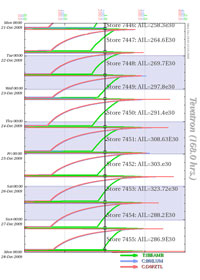Fermilab's Tevatron broke several records at the end of 2009. During the week of Dec. 21, 2009 the Tevatron set a record for the number of store hours: 151.25. During that same week, the Antiproton Source produced a record number of antiprotons, equivalent to 4,033 milliamps.
As physicists from Fermilab’s Tevatron collider experiments, CDF and DZero, prepare to share their newest results at upcoming winter 2010 physics conferences, they took a few moments recently to look back on the accomplishments of 2009.
“By every measure,” said DZero spokesperson and University of Manchester physicist Stefan Soldner-Rembold, “the Tevatron set new records and built upon its stellar physics program of exciting discoveries and ultra-precise measurements.”
Both CDF and DZero investigate proton-antiproton collisions at 2 TeV, the world’s highest energy for a particle-antiparticle collider. Combined, the two experiments involve over 1000 scientists from about 146 institutions in 27 countries. They have been operating the CDF and DZero experiments since 2001. The two collaborations expect to continue taking data through 2011, doubling the number of collisions that each experiment analyzed for their 2009 results.
“The Fermilab accelerator complex has continued to operate in superb fashion,” said CDF spokesperson Rob Roser. “The Tevatron set many new records for the number of collisions per second and the number of collisions delivered to experiments in a given week, month and year. The Tevatron has now substantially exceeded its design parameters, providing CDF and DZero physicists with ever-expanding scientific opportunities.”
In the final week of 2009, the Fermilab accelerator complex set a lifetime record for the hours of collider operation in a single week, producing 151 hours of physics data.
The experiments have made good use of the torrent of data. In 2009, they published over 100 scientific papers and presented more than 150 new results at physics conferences all over the world. Major highlights include the discovery of the production of single top quarks in the first observation of this extremely rare process. The collaborations made the world’s most precise measurement of the top-quark and W-boson masses with a precision of less than one per cent and one per mille, respectively; and they observed and studied new particles containing b quarks. By combining their data, the CDF and DZero experiments also reached important new conclusions on the possible mass of the proposed Higgs particle, now excluding a mass range near that of twice the mass of the W boson (162-166 GeV/c2).
“In 2009, CDF and DZero continued to push the boundaries of the unknown,” said Fermilab Director Pier Oddone. “They have a good opportunity to exclude the existence or see first evidence of the elusive Higgs particle over the next two years.”
While journal articles are the “currency” of fundamental research, they are not its only measure. Over 60 Ph.D. students graduated in 2009 after performing research at the Tevatron experiments, bringing the total number of Ph.D.’s to over 1000 since the Tevatron program began.
“Training new generations of scientists is a major success of the Tevatron program,” said DZero spokesperson Dmitri Denisov “In fact, a large fraction of the scientists now working at CERN’s Large Hadron Collider have trained at the Tevatron, bringing a wealth of experience with them to CERN.”
Fermilab physicists are watching with interest the restart of the LHC in Europe.
“We are all excited about the first LHC physics results,” said CDF spokesperson and University of Florida physicist Jacobo Konigsberg. “At the same time, we have had remarkable results from the Tevatron program at Fermilab over the past year, and we’re looking forward eagerly to what the coming months will reveal.”







